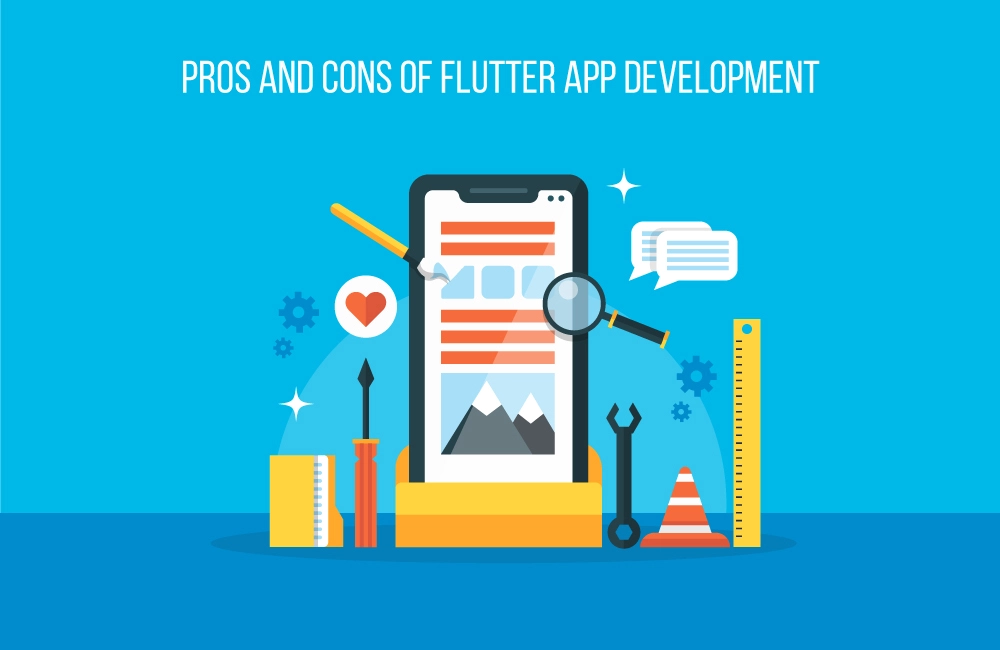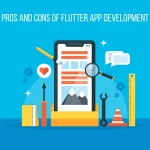Why flutter is better for app development: Pros and Cons of Flutter App Development
In the ever-evolving landscape of mobile flutter app development, Flutter has emerged as a powerful framework that promises to streamline the process of creating high-quality applications for both Android and iOS platforms. Developed by Google, Flutter has garnered attention for its potential to revolutionize app development with its unique approach and set of features. However, like any technology, it comes with its own set of advantages and limitations. In this comprehensive guide, we will delve into the pros and cons of Flutter app development to help you understand whether it’s the right choice for your next project.

| Pros | Cons |
|---|---|
| Single Codebase | Large File Size |
| Hot Reload | Limited Libraries and Plugins |
| Rich UI Experience | Learning Curve |
| High Performance | Platform Maturity |
| Access to Native Features | UI Consistency Challenges |
Pros of Flutter App Development
Single Codebase : One of the most significant advantages of Flutter app development is its ability to use a single codebase for both Android and iOS apps. This means developers can write code once and deploy it on multiple platforms, reducing development time and effort significantly.
Hot Reload : Flutter’s hot reload feature allows developers to instantly view changes made to the code on emulators, simulators, and hardware. This rapid iteration cycle speeds up development and debugging, making it easier to experiment with UI elements and fix issues on the fly.
Rich UI Experience : Flutter offers a rich set of customizable widgets that help developers create stunning and highly responsive user interfaces. These widgets follow specific design guidelines for both Android (Material Design) and iOS (Cupertino), ensuring a native look and feel on each platform.
High Performance : Flutter apps are compiled directly to native ARM code (no need for JavaScript bridges), resulting in high performance and faster startup times. This architecture also contributes to smooth animations and seamless scrolling, enhancing the overall user experience.
Access to Native Features : Flutter provides plugins that integrate with native code, allowing developers to access device-specific features such as camera, geolocation, Bluetooth, and more. This capability enables Flutter apps to leverage the full power of the underlying platform.
Strong Community and Support : With backing from Google and a growing community of developers, Flutter enjoys robust support and frequent updates. The community actively contributes plugins, packages, and solutions to common challenges, making it easier to extend functionality and resolve issues.
Cost-Effective Development : By reducing the time and effort required to develop and maintain separate codebases for Android and iOS, Flutter can lead to significant cost savings, especially for startups and small businesses.
Growing Popularity : Flutter is gaining popularity among developers due to its modern architecture and developer-friendly features. Its adoption by major companies like Alibaba, Google Ads, and Reflectly underscores its potential for building scalable and performant apps.
Ease of Maintenance : With a single codebase, maintaining Flutter apps becomes more straightforward compared to managing separate codebases for Android and iOS. Updates, bug fixes, and feature enhancements can be implemented uniformly across platforms, reducing maintenance overhead.
Faster Time to Market : Flutter’s productivity features such as hot reload, reusable widgets, and a cohesive development environment contribute to faster development cycles. This rapid iteration allows teams to iterate quickly, incorporate user feedback early, and launch apps faster, gaining a competitive edge.
Customizable Widgets : Flutter offers a wide range of customizable widgets out-of-the-box. Developers can create complex UI elements, animations, and interactions without relying extensively on platform-specific APIs or third-party libraries. This flexibility empowers developers to innovate and create unique user experiences.
Strong Performance on Older Devices : Flutter’s rendering engine, Skia, ensures consistent performance across a wide range of devices, including older smartphones and tablets. This capability is crucial for reaching broader audiences and ensuring a smooth user experience regardless of device specifications.
Predictable UI Behavior : Flutter’s reactive framework and widget-based architecture promote predictable UI behavior across different screen sizes, orientations, and platforms. This predictability simplifies the development process and reduces the likelihood of unexpected layout issues or inconsistencies.
Open Source and Customization : Being open-source, Flutter allows developers to inspect and modify its source code to suit specific project requirements. This openness encourages community contributions, fosters innovation, and provides developers with greater control over their development stack.
Cross-Platform Consistency : Flutter strives to deliver a consistent look and feel across platforms, adhering to Android’s Material Design and iOS’s Cupertino style guidelines. This consistency helps maintain brand identity and user experience standards across different devices and operating systems.
Cons of Flutter App Development
- Large File Size : Flutter apps tend to have larger file sizes compared to native apps because they include Flutter framework libraries. While Google has been working to optimize this, it can still be a consideration for apps where download size is critical.
- Limited Libraries and Plugins : Although Flutter has a growing ecosystem of packages and plugins, it may not yet match the breadth and depth of native development ecosystems. Developers may need to rely on custom development or native code integrations for certain functionalities.
- Learning Curve : While Flutter’s Dart programming language is relatively easy to learn for developers familiar with object-oriented programming, there is still a learning curve for those new to Flutter or Dart. Understanding Flutter’s reactive-style programming and widget-based architecture may take time.
- Platform Maturity : flutter app development is still evolving, and while Google provides strong support, some features and APIs may not be as mature or stable as those in native development environments. This could potentially lead to compatibility issues or additional development effort.
- UI Consistency Challenges : Despite Flutter’s promise of consistent UI across platforms, achieving pixel-perfect identical designs on both Android and iOS may require additional effort and customization. Design nuances and platform-specific behaviors may still need to be addressed.
- Enterprise Adoption Challenges : Larger enterprises may have existing investments in native development frameworks and tools. Migrating to Flutter may require overcoming organizational inertia, integrating with existing systems, and ensuring long-term support and scalability.
- SEO Limitations : Flutter is primarily designed for mobile app development and may not be suitable for web applications requiring strong SEO (Search Engine Optimization) capabilities. Hybrid solutions or separate web implementations may be needed for such scenarios.
- Tooling and IDE Support : While Flutter has strong support for popular IDEs like Visual Studio Code and Android Studio, tooling and plugin support may vary compared to mature native development environments. Developers may encounter occasional compatibility issues or limitations in tooling features.
- Long-Term Viability and Ecosystem : Despite its rapid growth, Flutter’s long-term viability in the competitive app development landscape remains a consideration. Evaluating ecosystem maturity, community support sustainability, and Google’s ongoing commitment to Flutter is crucial for making informed decisions.
- Localization and Internationalization : Flutter provides support for localization and internationalization, but managing translations and locale-specific behaviors may require additional effort compared to native development tools. Ensuring seamless multilingual support may involve custom solutions or third-party packages.
- Accessibility Features : While Flutter supports basic accessibility features, ensuring comprehensive accessibility compliance may require additional effort and customization. Developers need to consider platform-specific accessibility guidelines and implement custom solutions where Flutter’s capabilities are limited.
- Integration with Existing Native Code : Integrating Flutter modules into existing native apps or vice versa may pose challenges. Although Flutter offers plugins for accessing native code functionalities, complex integrations or legacy systems may require careful planning and expertise.
- Learning Resources and Expertise : While Flutter’s documentation and community resources are extensive, acquiring expertise in Flutter-specific development patterns, best practices, and advanced topics may require investment in training and learning resources. Accessing experienced Flutter developers can also be a consideration for team building.
- Dependency Management : Managing dependencies in Flutter projects can sometimes be challenging, especially when dealing with conflicting versions or compatibility issues between Flutter SDK updates and third-party packages. Careful dependency management practices are essential to maintaining project stability and performance.
- App Store Approval Processes : While Flutter apps generally comply with app store guidelines, occasional challenges in approval processes may arise due to specific platform requirements or policies. Staying informed about platform-specific guidelines and adapting Flutter apps accordingly can mitigate these issues.
Conclusion
Flutter represents a compelling option for cross-platform app development, offering significant advantages such as a single codebase, hot reload functionality, and a rich set of customizable widgets. These benefits make it particularly attractive for startups, businesses aiming to reduce time to market, and projects requiring a consistent user experience across Android and iOS.
However, developers should carefully weigh the drawbacks of flutter app development, including potential file size concerns, ecosystem maturity, platform-specific nuances, and integration challenges. Assessing project-specific needs, team expertise, long-term support considerations, and scalability requirements will help determine whether Flutter is the right choice for a particular app development endeavor.
As Flutter continues to evolve with community contributions and Google’s ongoing enhancements, it is poised to address many of its current limitations and solidify its position as a leading framework for modern app development. By staying informed, leveraging community resources, and adopting best practices, developers can maximize Flutter’s benefits and deliver exceptional mobile experiences to users worldwide.


